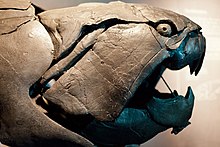
A | B | C | D | E | F | G | H | CH | I | J | K | L | M | N | O | P | Q | R | S | T | U | V | W | X | Y | Z | 0 | 1 | 2 | 3 | 4 | 5 | 6 | 7 | 8 | 9
| Fish Temporal range: Middle Cambrian – Recent
| |
|---|---|

| |
| Bala shark, a bony fish | |
| Scientific classification | |
| Domain: | Eukaryota |
| Kingdom: | Animalia |
| Phylum: | Chordata |
| Clade: | Olfactores |
| Subphylum: | Vertebrata |
| Groups included | |
| Cladistically included but traditionally excluded taxa | |
A fish (pl.: fish or fishes) is an aquatic, anamniotic, gill-bearing vertebrate animal with swimming fins and a hard skull, but lacking limbs with digits. Fish can be grouped into the more basal jawless fish and the more common jawed fish, the latter including all living cartilaginous and bony fish, as well as the extinct placoderms and acanthodians. Most fish are cold-blooded, their body temperature varying with the surrounding water, though some large active swimmers like white shark and tuna can hold a higher core temperature. Many fish can communicate acoustically with each other, such as during courtship displays.
The earliest fish appeared during the Cambrian as small filter feeders; they continued to evolve through the Paleozoic, diversifying into many forms. The earliest fish with dedicated respiratory gills and paired fins, the ostracoderms, had heavy bony plates that served as protective exoskeletons against invertebrate predators. The first fish with jaws, the placoderms, appeared in the Silurian and greatly diversified during the Devonian, the "Age of Fishes".
Bony fish, distinguished by the presence of swim bladders and later ossified endoskeletons, emerged as the dominant group of fish after the end-Devonian extinction wiped out the apex placoderms. Bony fish are further divided into the lobe-finned and ray-finned fish. About 96% of all living fish species today are teleosts, a crown group of ray-finned fish that can protrude their jaws. The tetrapods, a mostly terrestrial clade of vertebrates that have dominated the top trophic levels in both aquatic and terrestrial ecosystems since the Late Paleozoic, evolved from lobe-finned fish during the Carboniferous, developing air-breathing lungs homologous to swim bladders. Despite the cladistic lineage, tetrapods are usually not considered to be fish, making "fish" a paraphyletic group.
Fish have been an important natural resource for humans since prehistoric times, especially as food. Commercial and subsistence fishers harvest fish in wild fisheries or farm them in ponds or in breeding cages in the ocean. Fish are caught for recreation, or raised by fishkeepers as ornaments for private and public exhibition in aquaria and garden ponds. Fish have had a role in human culture through the ages, serving as deities, religious symbols, and as the subjects of art, books and movies.
Etymology
The word fish is inherited from Proto-Germanic, and is related to German Fisch, the Latin piscis and Old Irish īasc, though the exact root is unknown; some authorities reconstruct a Proto-Indo-European root *peysk-, attested only in Italic, Celtic, and Germanic.[1][2][3][4]
Evolution
Fossil history

About 530 million years ago during the Cambrian explosion, fishlike animals with a notochord and eyes at the front of the body, such as Haikouichthys, appear in the fossil record.[5] During the late Cambrian, other jawless forms such as conodonts appear.[6][7]
Jawed vertebrates appear in the Silurian, with giant armoured placoderms such as Dunkleosteus.[8] Jawed fish, too, appeared during the Silurian:[9] the cartilaginous Chondrichthyes[10][11] and the bony Osteichthyes.[12]
During the Devonian, fish diversity greatly increased, including among the placoderms, lobe-finned fishes, and early sharks, earning the Devonian the epithet "the age of fishes".[13][14]
Phylogeny
Fishes are a paraphyletic group, since any clade containing all fish, such as the Gnathostomata or (for bony fish) Osteichthyes, also contains the clade of tetrapods (four-limbed vertebrates, mostly terrestrial), which used not to be considered to be fish.[15][16] Some tetrapods, such as cetaceans and ichthyosaurs, have secondarily acquired a fish-like body shape through convergent evolution.[17] Fishes of the World comments that "it is increasingly widely accepted that tetrapods, including ourselves, are simply modified bony fishes, and so we are comfortable with using the taxon Osteichthyes as a clade, which now includes all tetrapods".[16] The biodiversity of extant fish is unevenly distributed among the various groups; teleosts, bony fishes able to protrude their jaws, make up 96% of fish species.[18][16] The cladogram[19] shows the evolutionary relationships of all groups of living fishes (with their respective diversity[16]) and the tetrapods.[20] Extinct groups are marked with a dagger (†); groups of uncertain placement[19] are labelled with a question mark (?) and dashed lines (- - - - -).




